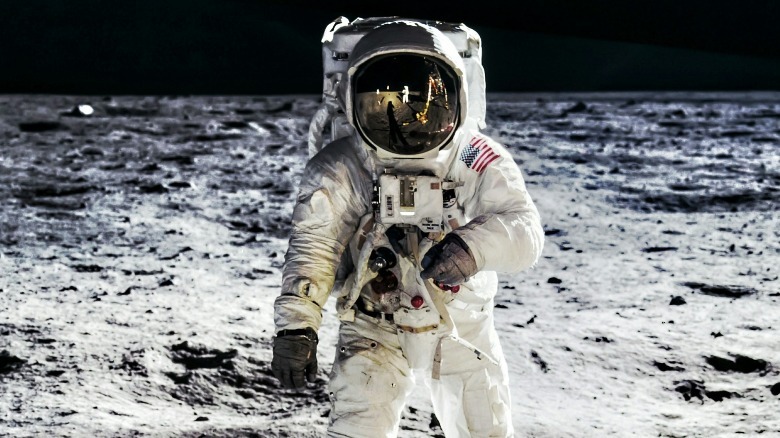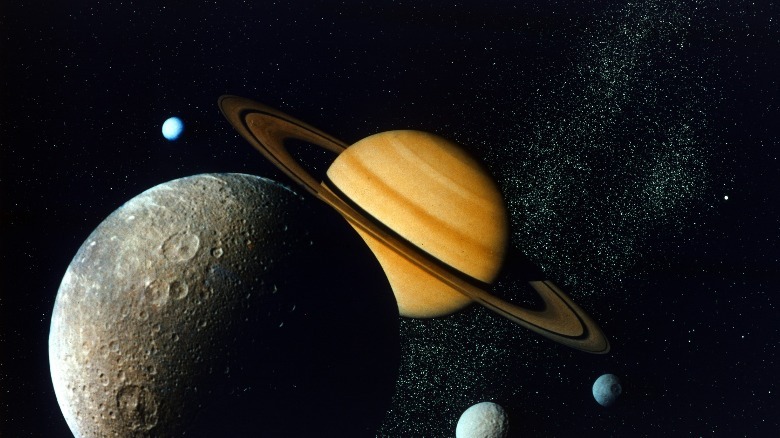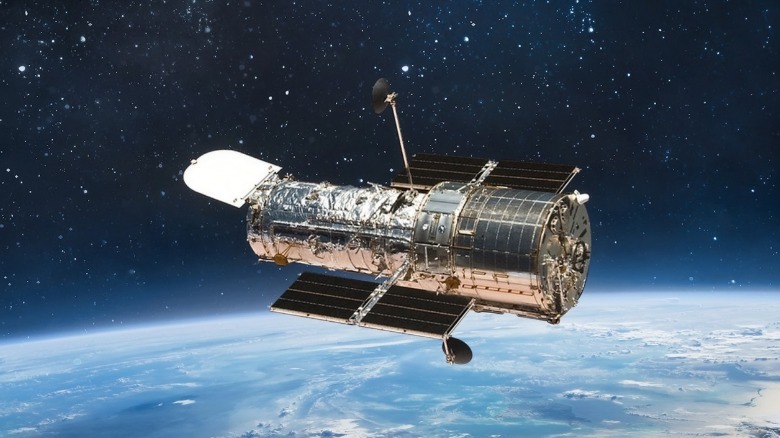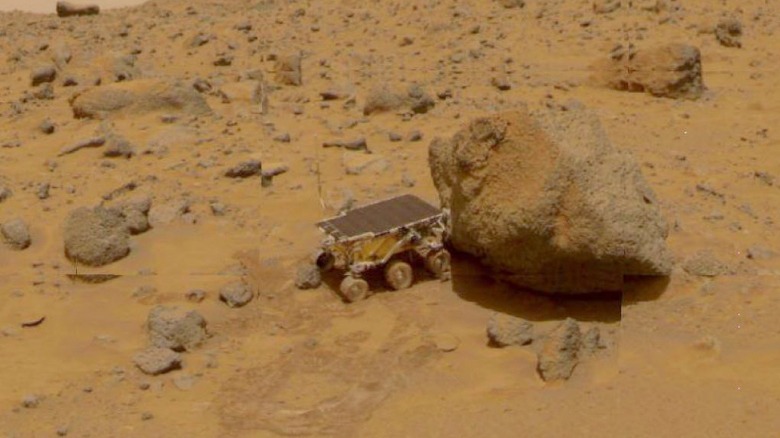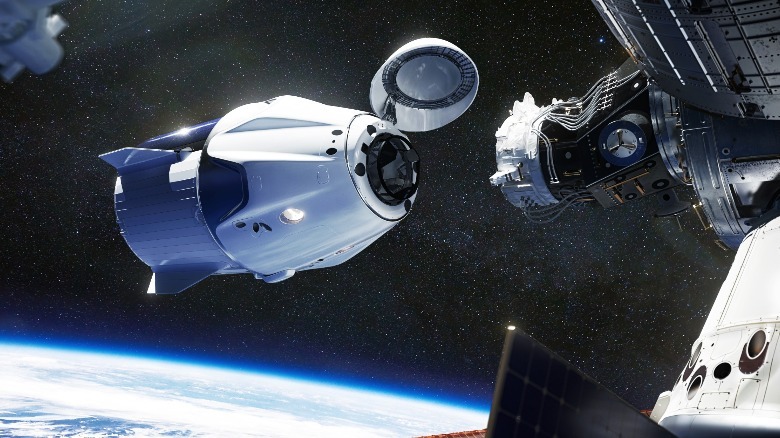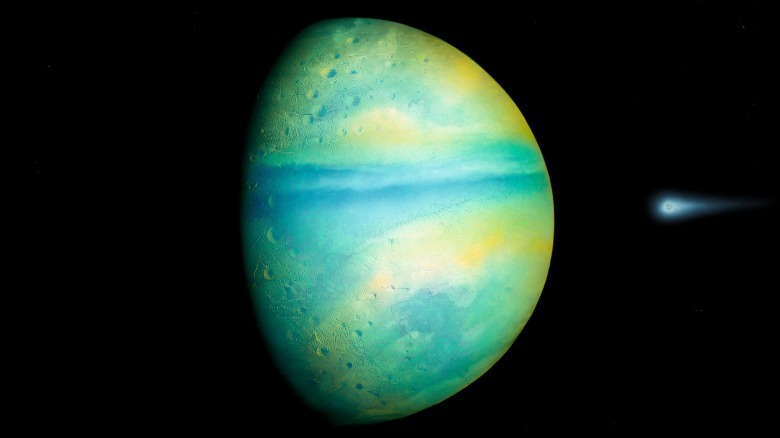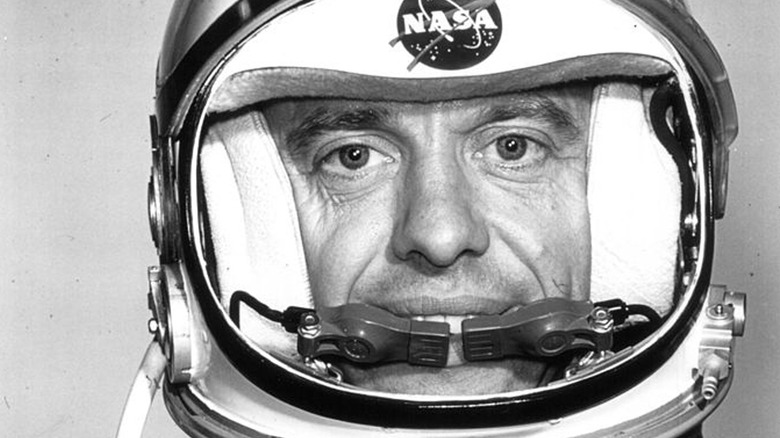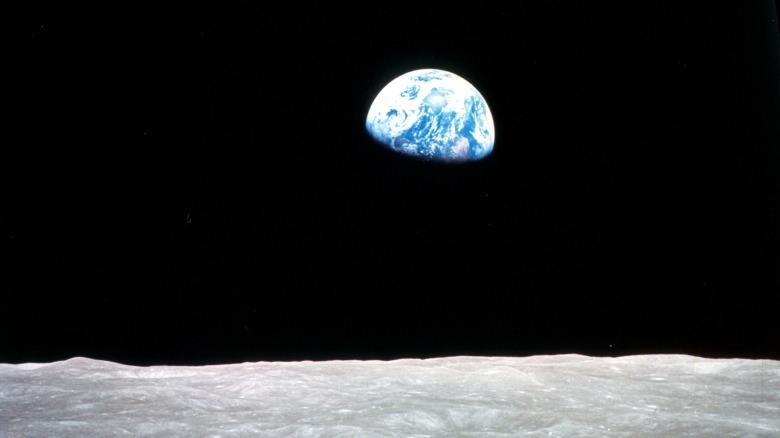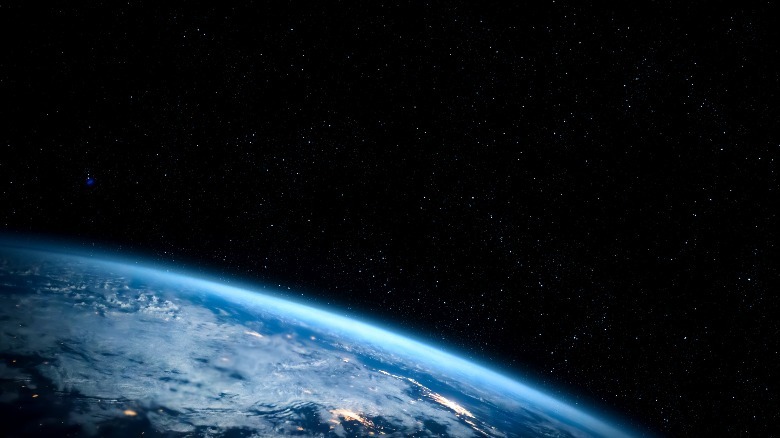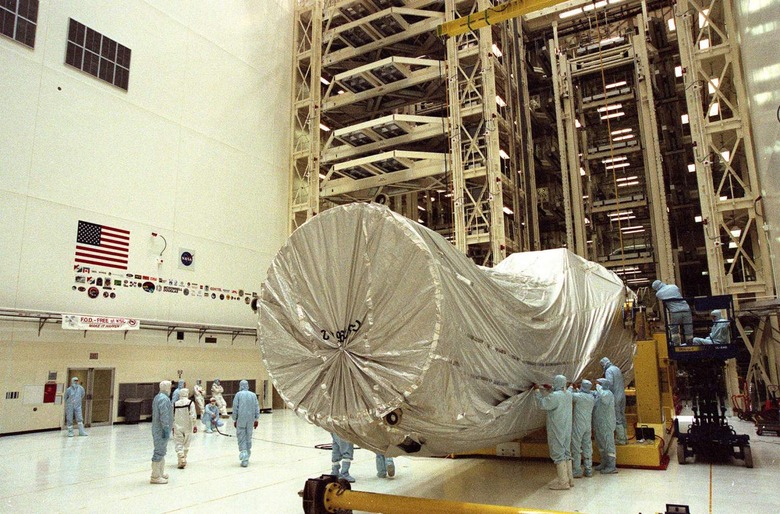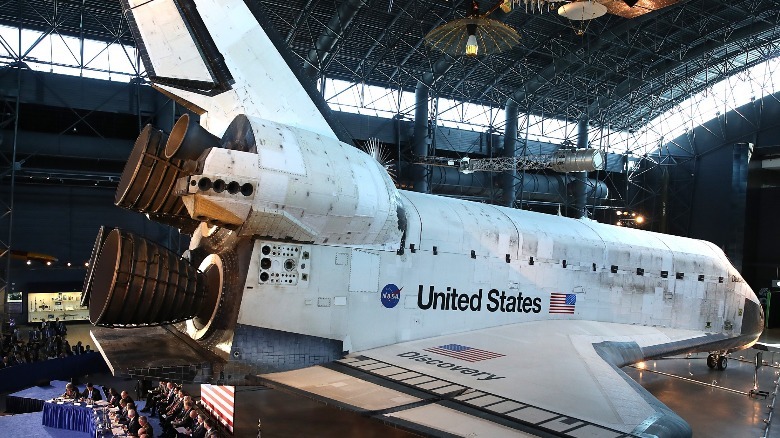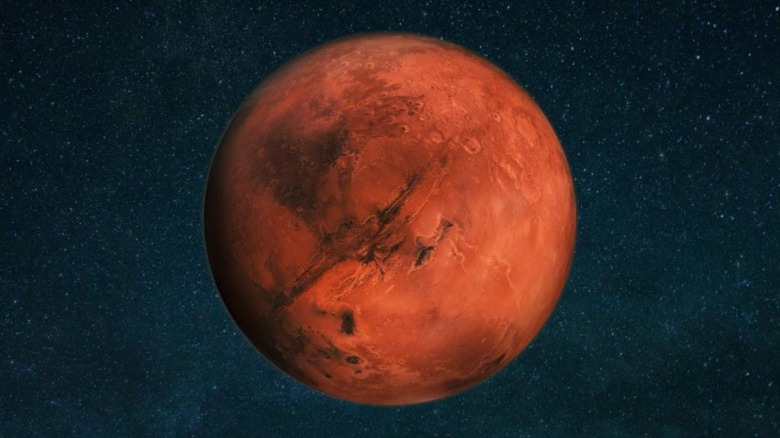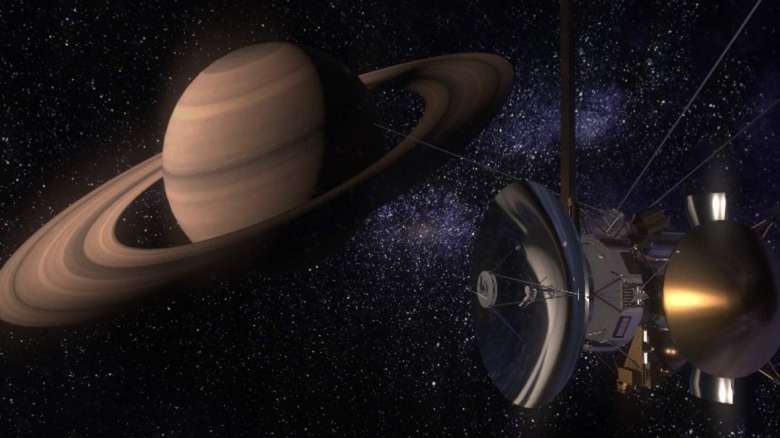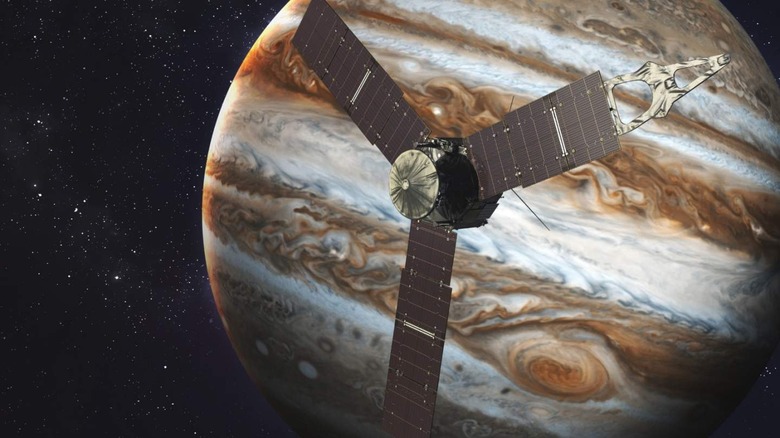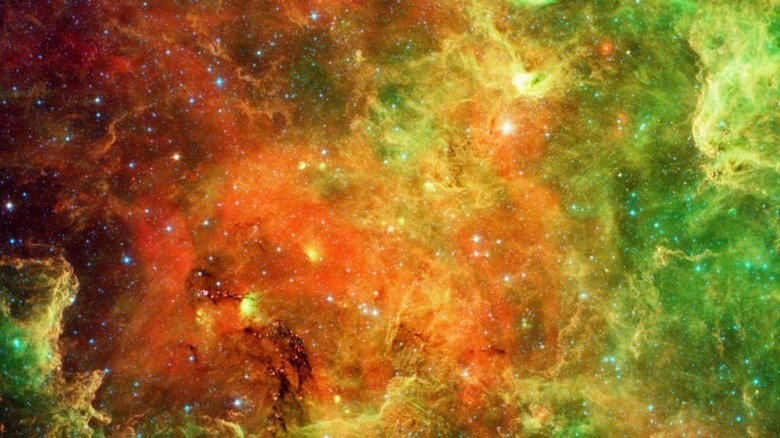The 15 Most Groundbreaking NASA Missions
Humankind has yearned to explore space since our ancestors began to study the night sky millennia ago. What we've been able to accomplish in the last 63+ years has taken the dedication, perseverance, and imagination of countless people. While many nations have aided in scores of missions outside of the Earth's atmosphere, NASA has certainly had the lion's share of firsts. Indeed, NASA successfully landed astronauts on the surface of the moon, collaborated with European governments on the exploration of Saturn's largest moon, and developed space telescopes that capture the far reaches of the universe. While this list isn't meant to outline every major accomplishment, it will lend some perspective on what this U.S. space agency has been able to achieve since its creation in 1958 (via History).
Formed in part as a response to the successful Soviet launch of the Sputnik satellite, NASA raced to pull the U.S. ahead of their Cold War rival by the end of the following decade. Throughout some serious tragedies that have taken the lives of nearly 30 NASA crewmembers in different incidents over the years, the space agency stayed the course and continues to pave the way for the continued exploration of worlds beyond our own.
Apollo 11 Moon Landing
When President John F. Kennedy gave his famous "We choose to go to the Moon" speech at Rice University on September 12, 1962, the United States was already behind the Soviets in the space race (via Science Focus). In an effort to boost both public and congressional support for increasing NASA's budget, Kennedy delivered an address that declared that the United States would land on the moon before the end of the decade.
The Apollo 11 mission was launched on July 16, 1969, carrying astronauts Neil Armstrong, Michael Collins, and Edwin "Buzz" Aldrin. Four days later on July 20, Aldrin and Armstrong touched down on the moon via the Lunar Module. Together, they spent 21 hours and 36 minutes on the surface of the Earth's moon (via NASA).
The three crew members of Apollo 11 safely splashed down in the Pacific Ocean on July 24. They were picked up by the recovery ship, the U.S.S. Hornet.
Humankind had finally accomplished a feat that only imagination could have previously captured. Altogether, it is estimated that 650 million people worldwide watched this event live, setting a new record that would be unsurpassed until Prince Charles married Lady Diana in 1981 (via Reference).
Voyager I
Some NASA missions primarily result in data being transmitted for several years. Others continue to give scientists information for decades. The latter is certainly the case for both the Voyager 1 and its sister spacecraft Voyager 2. First launched on September 5, 1977, the Voyager 1's primary mission was to perform fly-bys of Saturn and Jupiter and relay images back to Earth for study (via Solar System). More than 44 years later, this spacecraft is still being propelled through space, having left our solar system in August of 2012. It is still transmitting data to this day.
Onboard the Voyager 1 is the "Golden Record," which contains Earthly greetings to prospective other-worldly beings in over 55 languages. Recordings of music ranging from Chuck Berry to Beethoven are also contained in the record, as well as various images of Earth's people.
There have been many observations made by Voyager 1 that have helped map out our solar system. The discoveries of two additional moons of Jupiter (Thebe and Metis), a thin ring around Jupiter, and five newly observed moons of Saturn have changed the known makeup of the bodies that rotate around our sun.
Hubble Space Telescope
The ability to capture images far beyond what Earthly telescopes can achieve was recognized in 1990. On April 24th of that year, the Hubble Space Telescope was launched into orbit via the space shuttle Discovery. Orbiting the Earth at more than 300 miles above its surface, the Hubble has been transmitting images back to Earth for over 30 years now (via HubbleSite).
Hubble has been able to show the people of Earth both the beauty and vastness of the worlds that exist beyond what our naked eye sees. Hayden Planetarium director Neil deGrasse Tyson quipped, "No matter what Hubble reveals — planets, dense star fields, colorful interstellar nebulae, deadly black holes, graceful colliding galaxies, the large-scale structure of the Universe — each image establishes your own private vista on the cosmos," (via Rocket Stem).
Hubble is able to stay functional in part due to various servicing missions that keep the space telescope maintained and updated. The last servicing mission was carried out in 2009.
Mars Pathfinder
The first robotic rover to land on the surface of Mars, the Mars Pathfinder touched down on the surface of the Red Planet on July 4, 1997 (via NASA). Far outlasting its expected useful life, the Mars Pathfinder transmitted data to Earth until September 27, 1997, NASA also noted. Over that period, more than 2.3 billion bits of information were sent back to scientists on Earth, along with nearly 17,000 images.
NASA released information about an additional 15 separate soil tests conducted by The Pathfinder, in which the martian surface was analyzed. The test results concluded that the surface of Mars was once very wet and warm. Analyses of various rocks, along with the wind on the planet's surface, help to build a better picture of how wind erosion impacted the planet.
This spacecraft consisted of two parts: a space lander and a rover (via NASA). The lander was named the Carl Sagan Memorial Station after the late famed astronomer. The rover itself was given the moniker Sojourner, after 19th century abolitionist and civil rights leader Sojourner Truth.
International Space Station
The idea to maintain and constantly crew an orbiting space station was conceived early on in the NASA program. But it would take years of technological advances and international cooperation before this dream would become a reality. Under orders given by then-President Ronald Reagan, NASA began cooperating with the Japanese space program and the European Space Agency in 1984 (via ISS National Laboratory). By 1998, this collaboration would grow to include Russia's Roscosmos and the Canadian Space Agency (via National Geographic).
Construction started in late 1998 and the International Space Station (ISS) was first occupied in 2000. It has been continuously occupied since, sometimes with as few as three crew members aboard.
The ISS continues to grow, and improvements are almost always occurring. While crew members carry out a large portion of these duties, they are also tasked with experiments and lab studies. The results will help steer humankind in the direction of being able to live indefinitely off the surface of the Earth. Learning how to deal with near weightlessness, exposure to radiation, and other hazards of space travel are just part of what scientists need to overcome before this is possible.
As of April 2021, 244 people from nine nations have been aboard the ISS (via Space).
Kepler Spacecraft
Kepler was an orbiter craft launched on March 7, 2009 (via NASA). The primary purpose of this spacecraft was to discover and observe exoplanets that are within the Milky Way galaxy. Exoplanets, a name given to planetary bodies that exist outside of our solar system, could be detected by Kepler via its observation of distant stars. Kepler watched stars for dips in the light that they emitted. The only body large enough to cause a noticeable dip in a star's light would be an orbiting planet.
Designed to monitor over 100,000 stars for the existence of exoplanets, Kepler eventually discovered more than 2,600 of them (via Exoplanets). Kepler stopped transmitting to Earth in October 2018, after more than nine years.
The legacy of the Kepler spacecraft is the sheer number of exoplanets that are mapped out, coupled with the knowledge that it helped to show scientists just how many more planetary bodies there are within our galaxy.
Freedom 7 Mission
Not only did the Soviets launch the first successful satellite into orbit in 1957, but they also beat the United States in putting a human being into orbit. As noted by Space, on April 12, 1961, cosmonaut Yuri Gagarin orbited the Earth for 108 minutes while onboard the Vostok 1. Per NASA, not wanting to fall too far behind the Soviets, NASA recruited U.S. Navy test pilot Alan Shephard to be the first NASA astronaut to be sent into orbit. He was sent into space aboard the Mercury capsule (dubbed Freedom 7) on May 5, 1961.
While traveling in a sub-orbital trajectory for less time than his Soviet cosmonaut counterpart, Shephard went down in history as the first American to do so. This buoyed the spirits of the American people, as they saw that the United States remained capable of competing with the Soviets in the space race.
Shephard became an important figure within NASA, eventually walking on the surface of the moon during the Apollo 14 mission in 1971 (via Biography).
Apollo 8
Before NASA could attempt a human landing on the moon, it needed to show that doing so could be done safely. Simulations performed on Earth only show so much, and the data and projections from these endeavors really don't do any justice to what a real lunar landing is like. This is where the Apollo 8 mission came into play.
Launched into space on December 21, 1968, this Apollo mission carried aboard three crewmembers, astronauts Frank Borman, James A. Lovell, Jr., and William A. Anders. This was the first manned crew to leave aboard a rocket and the first to observe the Earth from a distance (via Solar System).
According to Smithsonian Air and Space, the purpose of Apollo 8 was to carry a crew to the moon and back, without landing on the moon's surface. In order to carry out an actual moon landing, it was first necessary to make certain that the Apollo program was capable of not only reaching the moon but could also successfully orbit this body.
As an aside, the astronauts aboard Apollo 8 were the first to capture images of the Earth from lunar orbit. Their stunning photographs are still widely circulated today.
Explorer 1
As noted above, the Soviet government's successful launch of the Sputnik space satellite on October 4th, 1957 sent the United States government into a panic. With the knowledge that the Soviets also shared the capacity for nuclear warfare, U.S. government officials foresaw a nightmare scenario in which their Cold War enemy would dominate the night sky, forcing the United States to be at their mercy.
Not wasting any time, the U.S. Army Ballistic Missile Agency commissioned the Jupiter rocket to carry its own satellite into orbit. On January 31, 1958, Explorer 1 was launched (via NASA). This satellite orbited the Earth more than 58,000 times before it crashed into the Earth's atmosphere on March 31, 1970.
With the success of Explorer 1, the space race stepped into high gear. The U.S. government immediately constructed additional Explorer satellites, attempting four subsequent launches throughout 1958. Of the five total Explorers launched, only three made it out of the Earth's atmosphere.
Chandra X-ray Observatory
The Chandra X-ray Observatory was launched on July 23, 1999. As the Earth itself absorbs X-rays as they enter its atmosphere, Chandra needed to be launched and situated beyond Earth's orbit. After a successful launch, Chandra became renowned for being the world's most powerful telescope (via NASA).
NASA launched the Chandra X-ray Observatory in order to detect and observe X-ray emissions from some of the hottest events in the universe. According to Chandra, this includes gathering data from stars that have exploded, areas around black holes, and galaxy clusters.
Four sensitive mirrors are on board, which bounce X-rays off of an optical bench. The images this observatory has captured include of a black hole in the center of the Milky Way galaxy, the separation of dark matter from normal matter, and the regions surrounding black holes. Chandra has also been able to detect black holes across the universe, helping scientists begin to map out the vastness of what lies beyond the naked eye.
The Space Shuttle
As the costs associated with one-time use rockets took their toll on the federal government's budget, NASA scientists began to imagine a reusable vessel that could carry astronauts safely to and from space. According to Spaceline, designers presented their plans for the original space shuttle in late 1969, with NASA hopeful that a successful launch would be achieved no later than 1977.
History tells us that NASA was a little off the mark in their prediction. The first successful shuttle launch occurred on April 12, 1981. On this date, astronauts John Young and Robert Crippen were launched into space aboard the space shuttle Columbia. This mission marked the first of many for this particular shuttle until disaster struck decades later. On February 1, 2003, the Columbia disintegrated upon re-entry into the Earth's atmosphere, killing all seven astronauts aboard the spacecraft.
Over the course of the so-called "Space Shuttle Era," NASA successfully launched five shuttles into space. Between the five shuttles, 135 shuttle missions were flown, carrying 833 different crew members. The shuttle program officially ended in 2011.
Viking I
July 20, 1976, marks the date when NASA first successfully landed a spacecraft on Mars (via Space). Following several failed Soviet attempts to land probes on the Red Planet, NASA's touchdown allowed the probe to transmit data for 90 days. The Viking probe was able to capture martian images for nearly six years, however.
Before transmission was ended in 1982, Viking 1 was able to send over 52,000 images back to Earth to be studied by scientists (via Solar System). It also successfully collected and analyzed soil samples from Mars, the results of which are still being analyzed. Scientists hope these photos provide a glimpse into how humans may be able to integrate into life on the red planet, with particular emphasis on how food might be grown sustainably.
Sophisticated instruments also were able to record temperatures on the surface of the planet at different times of the day and night. This data is being used, alongside the additional materials, to help determine how sending human astronauts to Mars can be safely accomplished in the future.
Cassini-Huygens Project
The Cassini-Huygens Project shows what can be accomplished when different space agencies pool their resources and knowledge to move humanity forward in the age of space exploration. With a mission to explore Saturn and its moons, this endeavor was a collaboration of the European Space Agency, NASA, and the Italian government's Agenzia Spaziale Italiana (via NASA's Jet Propulsion Laboratory). With a focus on the moon Titan, in particular, the Cassini-Huygens Project was developed to hopefully discover what chemical reactions are happening in this moon's atmosphere, as well as determine the source of the abundance of methane on Titan.
This mission consisted of two separate spacecraft, the Cassini orbiter and the Huygens probe. Cassini was constructed to continuously orbit Saturn, while the probe was to be launched from Cassini so that it could land on Titan.
Overall, this mission was structured so that the Cassini orbiter and the Huygens probe could conduct 27 separate scientific investigations. When the Huygens probe safely landed on the surface of Titan in 2005, scientists learned that the moon's surface had the consistency of wet sand and was comprised of tiny ice pebbles (via ESA Education). The probe also detected carbon dioxide on the ground, which wasn't found in Titan's atmosphere.
Cassini continued to orbit Saturn until September of 2017 when it ended its mission by plunging into Saturn's atmosphere and disintegrating.
Juno Spacecraft
Learning about the formation of what is perhaps the oldest planet in our solar system is key to learning about how our own planet was formed. Believed to have its beginning at a time when our sun was new, Jupiter was formed when massive amounts of dust and gases formed into a giant sphere (via Space).
Launched on August 5, 2011, the Juno spacecraft was engineered to give NASA scientists the most in-depth study of Jupiter to date. The mission was to hopefully learn more about Jupiter's origin, atmosphere, interior, and magnetosphere. While Jupiter has been observed to be a gaseous sphere, it is thought to have a stable and solid core. According to NASA, testing this theory is an additional aim of the spacecraft's mission.
As described by NASA and shared with Phys.org, this spacecraft is built to withstand the intense amount of radiation that is emitted from Jupiter. While it has been orbiting the solar system's largest planet, Juno has observed never-before-seen low lightning and detected water near Jupiter's equator.
The Spitzer Space Telescope
Launched in August 2003, the Spitzer Space Telescope has succeeded in being the first observatory to capture photos of planets that lie outside of our own solar system (via NASA). Known as extrasolar planets, images of these bodies were unable to be captured before this mission. Spitzer was able to discover the most remote planet from the Earth, orbiting a star nearly 13,000 light-years away. This telescope has also been able to capture a previously unknown ring of Saturn, a cluster of seven Earth-like planets rotating around a distant star, and has shown NASA the existence of the most remote galaxy in the universe, according to NASA (linked above).
The images transmitted from Spitzer are breathtaking. Since 2003, scientists have been able to study detailed photos showing weather conditions on some extrasolar planets, as well as photographic proof of water vapor on others (see link above).
What was originally intended to be a two-and-a-half-year mission has far exceeded NASA's expectations. Still in orbit, the telescope continued to send photos of bodies outside our solar system until the funding for this project ended on January 30, 2020 (via Space).

